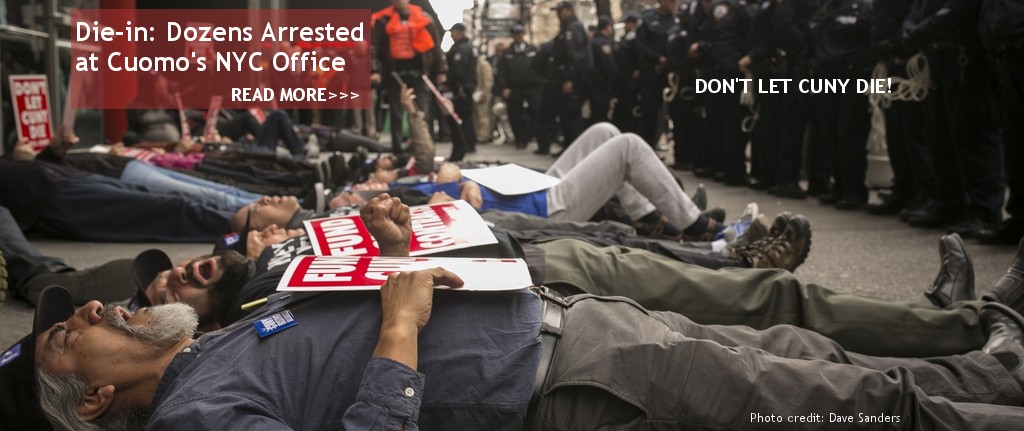By David Unger
“C-U-N-Y…Don’t Let CUNY Die!”
Over the past few years, we have been lying down on the pavements of New York. In Grand Central Station, in front of Barclay’s Center, in the middle of streets in Brooklyn, near Union Square, in Harlem and in the Bronx. We have been asked to lie down — to Die In — in order to demand recognition of Black Lives, to condemn violence against and killing of people of color, many of whose names are by now familiar in a tragic way: Sandra Bland, Eric Garner, Mike Brown, Tamir Rice, Trayvon Martin…and on and on.
Many times, everyone has been asked to die in, to lie down. Other times, white allies have been asked to stand in silence. Either way, the impacted communities have been calling the shots and leading the way.
At times, the die-ins have been done by “other groups,” including the Fight-for-15, Jews for Racial and Economic Justice (JFREJ), and others, marching in solidarity with the Movement for Black Lives and calling out the intersection between racial and economic violence. Each time, no matter what intersections have been highlighted, the violence against people of color has been the primary concern of the actions.
When I heard that there was going to be a direct action risking arrest in front of the Governor’s Office about the proposed decimation of CUNY’s budget, I volunteered without hesitation. But I will admit that when we were told that the action was going to be a Die-In, it gave me serious pause. Were we co-opting a tactic and image which has been so clearly connected in the past few years with institutionalized physical violence and death? Did we have a right to Die-In for CUNY?
CUNY — one of the largest university systems in the country — is one of the only affordable pathways to opportunity for the city’s underprivileged. Last fall, minority students made up around 75 percent of the student body, over half of whom were Pell Grant recipients, and about a third of whom came from households making less than $20,000 per year. CUNY students have already borne the brunt of $1,500 tuition hikes over the past five years, and could be looking at tuition doubling if the budget cuts go through.
I am told that it was a group of CUNY Students who told the Professional Staff Congress that they wanted to do a Die-In for CUNY, who started the chant of “C-U-N-Y…Don’t Let CUNY Die!”
Can we say that cutting higher education funding generally and cutting CUNY funding specifically is doing violence against communities of color and youth of color? Can it be argued that leaving CUNY Employees impoverished (as Cuomo has done by leaving CUNY’s DC37 members — largely workers of color — out of his “campaign” for $15 an hour) is doing violence against NYC’s communities of color?

There is a reason that CUNY staff, faculty and students were joined by a diverse group of racial and economic justice groups in the #CUNYRisingAlliance, calling for fully funding CUNY. There is no question about the potentially destructive impact of a massive cut in public education funding. Robbing communities of color of affordable access to higher education that provides one of the only paths to opportunity could be perpetuating and perpetrating harm against young people of color. For the impacted communities, robbing working people — largely workers of color — of living wages could be considered a type of violence against them.
I’m still not sure, am still conflicted about the broadening of the term “violence”, or the appropriating of a die-in in these times of continued physical risk for people of color. But I followed the lead of the students. Whether or not it “fits” the definition, there is no question about the potentially devastating impacts of these cuts, or the need for serious direct action against them. So, we stood, we marched, we lay down, and we shouted: “C-U-N-Y…Don’t let CUNY Die!”
I lay down among 40 fellow staff, faculty, and students with hundreds of supporters, including students and staff and community supporters, across the street. We linked arms, we shouted from flat on our backs, over and over: “C-U-N-Y…Don’t let CUNY Die!”
We felt the energy and support, we watched the press hover over us — as they only seem to do these days when actions contain arrests. We rode the bus together to the precinct, and many of those who “died-in” were changed by it. We felt powerful and united.
We may still have gotten that attention and feeling had we been arrested for sitting and linking up rather than “dying-in”. But at the end of the day, what is most important is that we took a stand. And on the bus to Police Headquarters, word spread that the Governor claimed to be backing down.
We can and must discuss the appropriateness of tactics and the imagery. We should be cognizant of the narratives and connections we are making. But we cannot pull back from the fight.
David Unger is Coordinator of Labor Relations Certificate Programs at the Murphy Institute.
Featured Photo Credit: Andrea Vazquez



